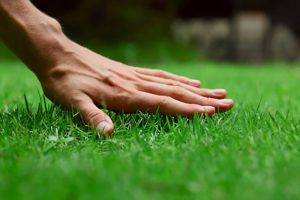
How Does Proper Fertilization Make Your Grass Greener and Healthier?
Providing your lawn with proper supplementation is vital. It can transform your lawn from average to the envy of the neighborhood. As with properly dosed multi-vitamins, you need to make sure you are adding the appropriate amount of missing nutrients that your lawn is lacking.
Step #1: Preparation
Taking the time to research your lawn is arguably the most important step and that is why preparation is the first step. You need to know which nutrients your soil is missing so that you can figure out what you need to add instead of experimenting with multiple lawn supplements. This measures the levels of nitrogen, phosphorus, and potassium– the three primary elements found in fertilizers. Many people are unaware but you can see which nutrients are missing from your lawn. One example, light green or yellow grass or plants are lacking necessary nitrogen.
Step #2: Choosing the Right Fertilizer
Once you know your lawn’s nutrients levels, it is time to pick out a good fertilizer. But you need to know how much you have to add to get your lawn at the optimum nutrient levels. Understanding these levels allows you to effectively select the right fertilizer for your lawn.
- Why is it important to understand the numbers? When looking at fertilizer packages, you might notice that it is a 20-10-20 fertilizer or something similar to that.
- What do those numbers mean? They represent the percentage of the fertilizer that is nitrogen, phosphorus, and potassium. While these don’t add up to 100%, filler ingredients make up the difference. Such ingredients are necessary to ensure the fertilizer is spread correctly.
- Optimum Measurements of NPK (measured in PPM). Below are the numbers you should expect to see when it comes to the optimal PPM for your lawn’s nutrients…
- Nitrogen – Between 20-29 ppm (parts per million- the concentration of the element). This is in the range of 70-100 pounds per acre.
- Phosphorus – Between 40-100 ppm
- Potassium – These can fluctuate quite a bit but as long as it is above 250 is ideal.
- pH Level – You should seek to achieve a level of 6 or 7, which is neutral but optimum for successful grass growth.
Step #3: Time to Fertilize
We’ve noticed that more fertilizers on the market are claiming that they are slow release. These fertilizer granules break down slowly, releasing the nutrients over a more drawn out period of time.
This reduces the amount of times you will have to apply fertilizer to the lawn which in turn reduces the amount of time you must devote to it.
- Why Shouldn’t You Use a Liquid Lawn Fertilizer? – While there are certain types of liquid lawn fertilizers that have proven to be beneficial. It is typically much better to use a granular fertilizer instead of a liquid spray. Granular fertilizers are better at achieving an even coverage. Sprays can be affected by even the slightest gust of wind which can prevent you from achieving the perfect coverage you were seeking.
- How Many Times Should You Fertilize Your Lawn Annually? – Ideally, you should apply fertilizer to your lawn 5 times over the season, beginning in mid-April or once you notice that your grass has started to grow– whichever comes first. Planning your five applications throughout the season until the first frost will be beneficial. This ensures that each fertilizing session is equally spaced apart which will help avoid over fertilizing your lawn.
- Avoid Overspreading Your Lawn Fertilizer – When spreading your fertilizer, you need to be cautious so that you don’t overdo it. We suggest starting with your spreader on a tighter setting– which will let less out. Then fill your spreader with only half of the recommended amount so you can see how far it will get you. Then you can finish the rest of your lawn accordingly. It is much better to do more applications on a tighter setting than to start loose and over fertilize your lawn. Overfertilization can burn your grass.
Proper Lawn Fertilization Means the Grass Will be Greener on Your Side
Professional landscapers nationwide will agree that supplementing your soil is essential to the growth of your lawn. While you can supplement your lawn on your own, you must plan and prepare to be successful. Test, apply, and retest is the best method when it comes to achieving proper fertilization. Correct supplementation puts a greener, healthier lawn right outside your door.
Contact us (859-314-LAWN) for more information or a free instant quote!
—
 About Green & Grow
About Green & Grow
Green & Grow is a full service lawn care company specializing in lawn mowing, fertilization & weed control, aeration & seeding, insect control, and more!
> Learn More

 About Green & Grow
About Green & Grow